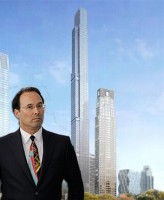There’s a tendency to dismiss Chinese institutional investors in New York as seekers of parking space. Slow and steady asset appreciation are the goals, observers say, rather than a big upside. Faced with a fraught economic environment back home, the Chinese just want to rest easy, it’s said, and their pillows of choice are trophy buildings.
While that’s still true when it comes to their investments in many parts of the U.S., the situation in Manhattan is now quite different: The Chinese are increasingly taking on luxury ground-up development projects, some of the most complex and risky bets in this town. And they’re doing it on their own terms.

Gary Barnett and the Central Park Tower
Just look at SMI USA. The U.S. arm of Shanghai Municipal Investment, which is Shanghai’s largest state-owned enterprise, has made three massive bets in the city over the past year: It partnered with Ceruzzi Properties [TRDataCustom] to buy a development site at 520 Fifth Avenue for $325 million, and then teamed up again with them to buy the land under the Lipstick Building for $453 million. It also bought a $300 million equity stake in Gary Barnett’s Central Park Tower development. The Lipstick deal is a somewhat traditional long-term, cash-flow deal. The other two are anything but.
At 520 Fifth, SMI plans to develop a $1 billion luxury condo project, likely with retail and a hotel component. It’s exactly the kind of venture that some local developers are shying away from, citing fears of oversupply and the difficulty of getting financing. And then there’s the Central Park Tower play: Barnett wants to take the crown back from 432 Park and build the tallest, glitziest residential building in the city, a sequel to One57. To a co-developer of the Shanghai Tower, the world’s second-tallest building, that likely sounded promising.
But SMI didn’t come easy — or cheap. Barnett has until July 31, 2017 to score a construction loan for the project, or he has to repay SMI with interest. If he can’t do that, he’ll be forced to sell the project. SMI will also receive monthly interest payments on its investment, according to Bloomberg, and must be consulted for major decisions on the project.
“It used to be that equity investors would take less control and less guarantees and share a bigger part of the upside,” One Ha’am’s Ori Eisenberg told Bloomberg. “Here, it’s the opposite.”

Kuafu Properties’ Stephen Muller
Kuafu Properties, which is backed by Chinese money, has spent over $750 million on a handful of properties, many of them development sites. At Hudson Rise, its mixed-use development on the Far West Side, Kuafu’s battles with its co-developers have delayed the project repeatedly. And though it paid a whopping $300 million for an East 60th Street assemblage with plans for a large condo tower, it will now wait until the music starts again. “We acquired that asset with the next cycle in mind,” Stephen Muller, the company’s chief investment officer, said in April. “And so, we levered accordingly.”
SMI’s hard bargain with Extell and Kuafu’s willingness to take on partners and play the waiting game suggest a new breed of Chinese investor in New York: Willing to embrace the risk of building in Manhattan, but ready to do battle if it comes down to that.
